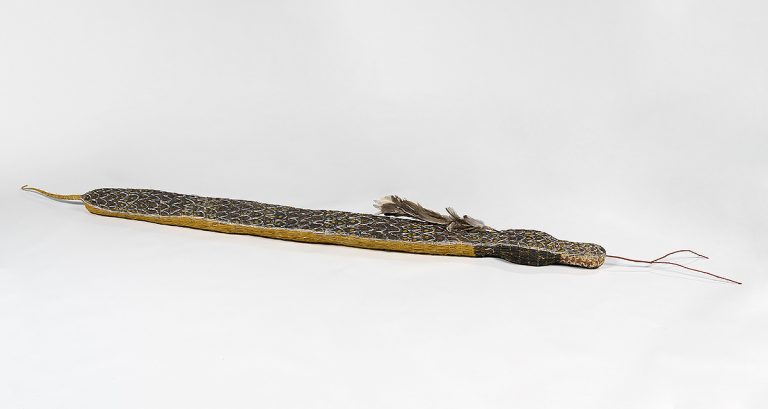We acknowledge the Traditional Owners of the land on which the Queensland Art Gallery | Gallery of Modern Art stands and recognise the creative contribution First Australians make to the art and culture of this country.

Lena Yarinkura / Kune/Rembarrnga people / Australia b.1961 / Ngalyod (Rainbow serpent) 2004 / Twined pandanus palm leaf (Pandanus spiralis), wood, feathers, paperbark with natural pigments / 23.5 x 370 x 14cm (complete); snake: 15 x 341.5 x 14cm; tongue: 4 x 23.5 x 59cm; feathers: 8.5 x 14 x 68.5cm / Purchased 2004. The Queensland Government’s special Centenary Fund / Collection: Queensland Art Gallery | Gallery of Modern Art / © Lena Yarinkura/Licensed by Viscopy, 2010
Lena YarinkuraNgalyod (Rainbow serpent) 2004
Not Currently on Display
The body of Lena Yarinkura’s Ngalyod (Rainbow serpent) is fashioned from woven pandanus strands and stuffed with soft paperbark. Ngalyod is a powerful figure for Aboriginal people throughout Australia.
It can take both male and female forms, but in western central Arnhem Land, where Yarinkura lives, the serpent is most commonly believed to be female, with powers of creation and destruction. Ngalyod is associated with the bodies of water where she resides — billabongs, creeks and rivers — and particularly the monsoonal rains.
Lena Yarinkura is a Kune-Rembarrnga woman and she lives outside Maningrida in central Arnhem Land. Yarinkura learned to make the conventional range of twined basketry from her mother but soon began experimenting with different shapes and stitch combinations. Later, collaborating with her husband Bob Burruwal, Yarinkura began painting on bark, which invigorated her fibre works. By 1994, she was making life-size figures of paperbark bound with string.
Discussion Questions
1. Look closely at the materials that Lena Yarinkura has used to make her sculpture. How many different materials can you identify?
2. Research the significance of the Rainbow Serpent motif in Indigenous Australian art. Are there any stylistic variations?
Classroom Activities
Create a soft sculpture in the form of an animal. Use fibre cloth, such as calico, and other natural materials to construct the shape. Stuff the soft sculpture with shredded paper to form a three-dimensional shape. Paint the surface to capture the identity of the animal, and consider using texture and camouflage in your design.